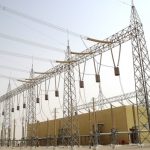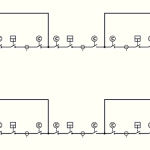A ring bus configuration is an extension of the sectionalized bus arrangement and is accomplished by interconnecting the two open ends of the buses through another sectionalizing breaker.
This results in a closed loop or ring with each bus section separated by a circuit breaker. For maximum reliability and operational flexibility, each section should supply only one circuit.
In this arrangement, as with the sectionalized bus configuration,only limited bus sections and circuits are removed from service because of line or bus faults or circuit breaker failure. For a line or bus fault, the two circuit breakers on the sides of the affected bus section open to isolate the fault. The remaining circuits operate without interruption.
For a breaker failure, the two breakers on the sides of the affected breaker open, along with a transfer trip to a remote breaker, to isolate the failed breaker and remove two bus sections from service.
The ring bus arrangement provides for circuit breaker maintenance since any breaker can normally be removed from service without interruption of service to any circuits.
As a result, separate circuit breaker bypass facilities are not required.
 Figure 6 – Ring bus configuration
Figure 6 – Ring bus configuration
A number of equipment arrangements may be used to provide a ring bus configuration, depending on anticipated substation expansion and possible system modifications. Figure 6 illustrates a typical ring bus configuration.
The arrangement shows four circuit positions, which is a practical maximum for a ring bus configuration. Rather than expanding the ring bus to accommodate additional circuits, other more flexible and reliable configurations, such as the breaker-and-a-half scheme, can be adopted.
The ring bus arrangement shown in Figure 6 is readily adaptable in the future to a breaker-and-a-half configuration as shown in Figure 7 below. However, the relay and control panels have to be carefully planned to be modified later for breaker-and-a-half operation.
Bay centerline spacing should be carefully planned to permit equipment maintenance and removal.
Advantages
· Flexible operation.
· High reliability.
· Isolation of bus sections and circuit breakers for maintenance without disrupting circuit operation.
· Double feed to each circuit.
· No main buses.
· Expandable to breaker-and-a-half configuration.
· Economic design.
Disadvantages
· Ring may be split by faults on two circuits or a fault during breaker maintenance to leave possibly undesirable circuit combinations (supply/load) on the remaining bus sections. Some consider this, however, to be a second contingency factor.
· Each circuit has to have its own potential source for relaying.
· This configuration is usually limited to four circuit positions, although larger rings are in service, including 10-position ring buses.
A 6-position ring bus is usually considered as a maximum limit for the number of terminals in a ring bus.
· This is a more involved relay scheme since each breaker has to respond to faults on two circuits.
· Automatic reclose schemes may be complex.



Comments are closed